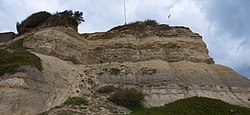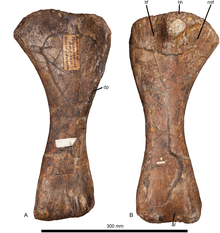Wealden Group
| Wealden Group | |
|---|---|
| Stratigraphic range: Late Berriasian-Aptian, | |
 Coastal exposure of the Wealden Group near Bexhill-on-Sea | |
| Type | Group |
| Sub-units | |
| Underlies | Lower Greensand Group |
| Overlies | Purbeck Group |
| Thickness | Up to 850 m in Weald Basin, c. 500 m in Wessex basin, few m in marginal areas |
| Location | |
| Region | England |
| Country | |
| Type section | |
| Named for | Weald |
The Wealden Group, occasionally also referred to as the Wealden Supergroup, is a group (a sequence of rock strata) in the lithostratigraphy of southern England. The Wealden group consists of paralic to continental (freshwater) facies sedimentary rocks of Berriasian to Aptian age and thus forms part of the English Lower Cretaceous. It is composed of alternating sands and clays. The sandy units were deposited in a flood plain of braided rivers, the clays mostly in a lagoonal coastal plain.[1]
The Wealden Group can be found in almost all Early Cretaceous basins of England: its outcrops curve from the Wessex Basin in the south to the Cleveland Basin in the northeast. It is not found in northwest England and Wales, areas which were at the time tectonic highs where no deposition took place. The same is true for the London Platform around London and Essex. Offshore, the Wealden Group can reach a thickness of 700 metres.[1] The terms Wealden and Wealden facies are also used as generic terms referring to Early Cretaceous non-marine sequences elsewhere in Europe.
Stratigraphy
[edit]The Wealden Group lies stratigraphically on top of the Purbeck Group, which spans the Jurassic-Cretaceous boundary. Within the Wessex Basin, the Wealden Group consists of two formations: the Wessex Formation and overlying Vectis Formation. In the Weald Basin, the Wealden Group consists of four formations: the Ashdown Formation, the Wadhurst Clay Formation, the Tunbridge Wells Sand Formation and the Weald Clay Formation.[2] The lower three formations are sometimes collectively referred to as the Hastings Beds. In Oxfordshire, Buckinghamshire and Wiltshire, the Wealden Group is only found as an outlier on top of hills and only consists of a single formation, the Whitchurch Sand Formation. In Yorkshire, the equivalently aged Speeton Clay Formation, a marine unit, is present.
On top of the Wealden Group is the Lower Greensand Group. The difference between these two groups has been formed by a major eustatic (global) transgression of the sea. The Greensand (Aptian/Albian in age) consists of marine deposits.
The sequence in the Weald Basin has also been described as a supergroup, containing the Weald Clay Group and Hastings Group.[3]
Palaeontology
[edit]The Wealden Group forms outcrops covering a large part of south and south-eastern England including the Isle of Wight. It takes its name from the Weald region of Kent, Sussex, Surrey and Hampshire. It has yielded many fossils, including dinosaurs like Iguanodon and Hypsilophodon.[4] Apart from fossils, it shows many other signs of being deposited in a continental environment, such as mudcracks and -in some rare cases- dinosaur footprints. Taxa included in the table below have an uncertain provenance and cannot be placed into one of the constituent formations, thus they are placed here.
Pterosaurs
[edit]| Pterosaurs reported from the Wealden Group | ||||||
|---|---|---|---|---|---|---|
| Genus | Species | Location | Stratigraphic position | Material | Notes | Images |
| Coloborhynchus | C. clavirostris[5] |
|
Hastings Beds | "Anterior portion of rostrum"[5] | An ornithocheirid pterosaur. |  |
Dinosaurs
[edit]| Dinosaurs reported from the Wealden Group | ||||||
|---|---|---|---|---|---|---|
| Genus | Species | Location | Stratigraphic position | Material | Notes | Images |
| Thecospondylus[6] | T. horneri[6] |
|
Hastings Beds | "Internal mold of sacrum."[7] | Dubious genus that has been variously classified as either a saurischian or ornithischian.[8] It is currently only tentatively regarded as dinosaurian.[6] |  |
| Therosaurus[9] | T. anglicus[9] |
|
||||
| Altispinax[10] | A. dunkeri[10] |
|
Hastings Beds | "Dorsal vertebrae."[11] |  | |
| Haestasaurus[12] | H. becklesii[10] |
|
Hastings Beds | Forelimb | A ?basal macronarian | |
| Pleurocoelus[13] | P. valdensis[13] | A dubious basal titanosauriform[13] | ||||
| Turiasauria | Indeterminate | Hasting beds?[14] | Vertebra[14] | |||
| Theropoda | Indeterminate |
|
||||
Wealden elsewhere in Europe
[edit]The term "Wealden" and "Wealden facies" has been applied to other Lower Cretaceous sequences in Europe, including the "German Wealden", comprising the Berriasian aged Bückeberg Formation of the Lower Saxony Basin[16] and in Belgium, where "Wealden facies" has been used as a term to refer to the Barremian-Aptian aged sequences of the Mons Basin, including the Sainte-Barbe Clays Formation where large numbers of Iguanodon were found in the 19th century.[17]
References
[edit]- ^ a b Jackson (2008)
- ^ Hopson PM, Wilkinson IP, Woods MA (2008). "A stratigraphical framework for the Lower Cretaceous of England" (PDF). British Geological Survey Research Report , RR/08/03. British Geological Survey.
- ^ Benson RB, Brusatte SL, Hutt S, Naish D (2009). "A new large basal tetanuran (Dinosauria: Theropoda) from the Wessex Formation (Barremian) of the Isle Of Wight, England". Journal of Vertebrate Paleontology. 29 (2): 612–615. Bibcode:2009JVPal..29..612B. doi:10.1671/039.029.0202. S2CID 83869634.
- ^ Weishampel et al. (2004)
- ^ a b c Rodrigues T, Kellner AW (2013). "Taxonomic review of the Ornithocheirus complex (Pterosauria) from the Cretaceous of England". ZooKeys (308): 1–112. Bibcode:2013ZooK..308....1R. doi:10.3897/zookeys.308.5559. PMC 3689139. PMID 23794925.
- ^ a b c d "10.21 Kent, England; 1. Hastings Beds"in Weishampel, et al. (2004). Page 559.
- ^ "Table 2.1," in Weishampel, et al. (2004). Page 26.
- ^ Huene, 1909. Skizze zu einer Systematik und Stammesgeschichte der Dinosaurier [Sketch of the systematics and origins of the dinosaurs]. Centralblatt für Mineralogie, Geologie und Paläontologie. 1909, 12-22.
- ^ a b c d "10.18 West Sussex, England; 1. Hastings Beds" in Weishampel, et al. (2004). Page 559.
- ^ a b c d e f "10.19 East Sussex, England; 1. Hastings Beds" in Weishampel, et al. (2004). Page 559.
- ^ "Table 4.1," in Weishampel, et al. (2004). Page 73.
- ^ Paul Upchurch, Philip D. Mannion & Michael P. Taylor (2015) The Anatomy and Phylogenetic Relationships of “Pelorosaurus“ becklesii (Neosauropoda, Macronaria) from the Early Cretaceous of England. PLoS ONE 10(6): e0125819. doi:10.1371/journal.pone.0125819 http://journals.plos.org/plosone/article?id=10.1371/journal.pone.0125819
- ^ a b c "10.19 East Sussex, England; 1. Hastings Beds" and "10.18 West Sussex, England; 1. Hastings Beds" in Weishampel, et al. (2004). Page 559.
- ^ a b Mannion PD (24 January 2019). "A turiasaurian sauropod dinosaur from the Early Cretaceous Wealden Supergroup of the United Kingdom". PeerJ. 7: e6348. doi:10.7717/peerj.6348. PMC 6348093. PMID 30697494.
- ^ "10.19 East Sussex, England; 1. Hastings Beds" and "10.18 West Sussex, England; 1. Hastings Beds" and "10.21 Kent, England; 1. Hastings Beds"in Weishampel, et al. (2004). Page 559.
- ^ Richter, Annette (2012). "The 'German Wealden' and the Obernkirchen Sandstone – an Introduction". Dinosaur Tracks 2011: an international symposium, Obernkirchen, April 14-17, 2011 : abstract volume and field guide to excursions. Göttingen: Universitätsverlag Göttingen. ISBN 978-3-86395-105-4. OCLC 852208407.
- ^ Dejax, J.; Pons, D.; Yans, J. (1 April 2007). "Palynology of the dinosaur-bearing Wealden facies in the natural pit of Bernissart (Belgium)" (PDF). Review of Palaeobotany and Palynology. Aspects of the Jurassic and Cretaceous palynology. 144 (1): 25–38. Bibcode:2007RPaPa.144...25D. doi:10.1016/j.revpalbo.2005.10.004. ISSN 0034-6667.
Further reading
[edit]- Jackson AA (2008). Bedrock geology UK south. An explanation of the bedrock geology map of England and Wales - 1:625,000 edition. Keyworth, Nottingham: British Geological Survey. ISBN 978-0-85272-586-3.
- Weishampel DB, Barrett PM, Coria RA, Le Loeuff J, Xu X, Zhao X, Sahni A, Gomani EM, Noto CR (2004). "Dinosaur distribution". In Weishampel DB, Dodson P, Osmólska H (eds.). The Dinosauria. University of California Press, Berkeley. pp. 517–606.

